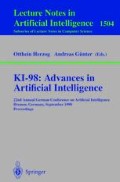Abstract
Every knowledge representation language is a thinly disguised version of logic, often with a specialized ontology built into the notation. The number of possible notations for pure logic and the number of ontologies that could be combined with them are infinite. No single notation can ever be ideal for all possible applications, and new ones will always be found that can help to simplify various kinds of problems. Fortunately, the great diversity of logics can all be related to one another through a relatively small number of fundamental principles. This paper presents some examples that illustrate the advantages of different representation and the methods of mapping one to another.
Preview
Unable to display preview. Download preview PDF.
Bibliography
E. W. Beth. Semantic Entailment and Formal Derivability. North-Holland Publishing Co., Amsterdam, 1955.
R. Carnap. Autobiography. In P. Schilpp, editor, The Philosophy of Rudolf Carnap, pages 3–84. Open Court Press, La Salle, IL????
R. Carnap. Einf"uhrung in die symbolische Logik. Dover Publications, New York, 1954. translated as Introduction to Symbolic Logic and its Applications.
R. E. Fikes and N. J. Nilsson. Strips: A new approach to the application of theorem proving to problem solving. Artificial Intelligence, 2: 189–208, 1971.
G. Gentzen. Untersuchungen über das logische Schliessen I II. North-Holland Publishing Co., Amsterdam, 1935. English translation in The Collected Papers of Gerhard Gentzen, pp. 68–131.
P. Gr"unewald. Causation and nonmonotonic temporal reasoning. In G. Brewka, C. Habel, and B. Nebel, editors, KI-97: Advances in Artificial Intelligence, LNAI 1303, pages 159–170. Springer Verlag, Berlin, 1997.
S. Hanks and D. McDermott. Nonmonotonic logic and temporal projection. Artificial Intelligence, 33: 379–412, 1987.
H. Kamp. Events, discourse representations, and temporal references. Langages, 64: 39–64, 1981.
J. McCarthy. Situations, actions, and causal laws. In M. Stanford AI Memo No. 2. Reprinted in Minsky, editor, Semantic Information Processing, pages 410–418. MIT Press, Cambridge, MA, 1963.
J. McCarthy and P. Hayes. Some philosophical problems from the standpoint of artificial intelligence. Edinburgh University Press, 1969.
J. Pearl. Fusion, propagation, and structuring in belief networks. Artificial Intelligence, 29: 241–288, 1986.
J. Pearl. Probabilistic Reasoning in Intelligent Systems. Morgan Kaufmann Publishers, San Mateo, CA, 1988.
C. S. Peirce. On the algebra of logic. American Journal of Mathematics, 7: 180–202, 1985.
C. Rieger. An organization of knowledge for problem solving and language comprehension. Artificial Intelligence, 7: 89–127, 1976.
D. D. Roberts. The Existential Graphs of Charles S. Peirce. Mouton, The Hague, 1973.
J. A. Robinson. A machine oriented logic based on the resolution principle. Journal of the ACM, 12: 23–41, 1965.
J. F. Sowa. Conceptual Structures: Information Processing in Mind and Machine. Addison-Wesley, Reading, MA, 1984.
J. F. Sowa. Knowledge Representation: Logical, Philosophical, and Computational Foundations. PWS Publishing Co., Pacific Grove, CA, 1999.
A. S. Troelstra. Lectures on Linear Logic. CSLI, Stanford, CA, 1992.
E. R. Tufte. Visual Explanations: Images and Quantities, Evidence and Narrative. Graphics Press, 1997.
Editor information
Rights and permissions
Copyright information
© 1998 Springer-Verlag Berlin Heidelberg
About this paper
Cite this paper
Sowa, J.F. (1998). The infinite variety of logics. In: Herzog, O., Günter, A. (eds) KI-98: Advances in Artificial Intelligence. KI 1998. Lecture Notes in Computer Science, vol 1504. Springer, Berlin, Heidelberg . https://doi.org/10.1007/BFb0095426
Download citation
DOI: https://doi.org/10.1007/BFb0095426
Published:
Publisher Name: Springer, Berlin, Heidelberg
Print ISBN: 978-3-540-65080-5
Online ISBN: 978-3-540-49656-4
eBook Packages: Springer Book Archive

